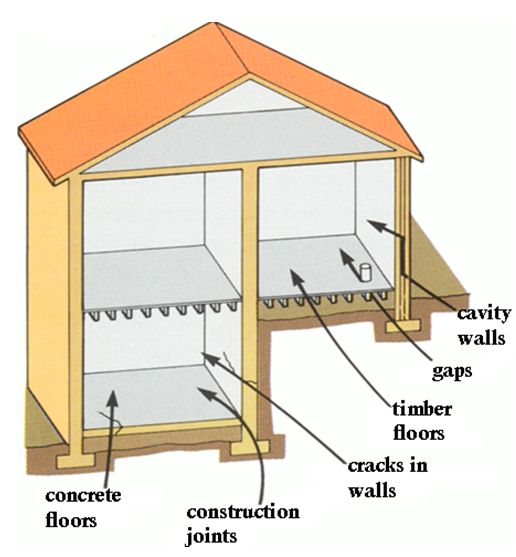What is radon?
Radon is a naturally occurring radioactive gas entering buildings from the underlying ground. Radon is a colourless and odourless radioactive gas generated by the radioactive decay of radium (Ra226) which in turn derives from the radioactive decay of uranium (U238). Uranium is found in minute quantities in all soils and rocks, although the concentration varies from one geographical location to another.
Radon in soils and rocks mixes with air and rises to the surface where it quickly dilutes in the atmosphere. As a consequence radon concentrations in open air and well ventilated habitations are very low. However when radon moves through openings, cracks and fissures into buildings and dwellings from the subsoil into the habitation, it can reach relatively high concentrations to constitute a health hazard for the inhabitants.
A house actually acts as a chimney. Due to heating of the air, it rises to the top of the building, thereby creating a suction of air from the lower part of the house, towards the higher part of the house. This actually means that air from the ground beneath the house is sucked into the house through numerous openings.

Radon will kill you!
Radon is known to be the second largest cause of lung cancer after smoking. Some studies indicate that radon is the primary cause of 10 to 15% of lung cancer mortalities. This means that in Denmark about 400 people die every year of lung cancer caused by radon. In England the figure is 4000 persons and in Sweden unconfirmed studies indicate some 800 persons.
Where is it found?
The presence of Radon depends on the geological structure of the underground. The following areas are classified as Radon contained:
| Severe |
Medium |
Mild |
- Finland
- Sweden - south & mid
- Norway - south & mid
- Ireland
- France
- Spain
- Austria
- Switzerland
- Italy - northern part
- Greece - southern part
|
- Denmark
- Germany
- Italy
- UK -south/west
- Belgium
|
|
Source: NRPB, National Radiological Protection Board UK
How is it measured
Radon concentration is measured in Bequerel per M3 (Bq/M3) of air. At present there is no common European legislation in place governing the health risk levels of radon, but the action level for radon concentration within Europe and the USA is generally acknowledged at 200 Bq/M3. At this level of concentration the building owner should engage some sort of mitigation measure.
How to reduce the risk?
Radon is everywhere and cannot be entirely removed from a property but the level can be reduced sub-stantially below those considered to be harmful to health. The most efficient and cost effective way of reducing the radon level in a house is to reduce its initial entry into the building by installing a mechanical barrier. A mechanical barrier alone will not be enough - ventilation of the building must also be improved.
Radon is excluded from buildings using passive and active systems. The provision of a suitable protection system, designed and installed by competent personnel, will substantially reduce the risk of a building hav-ing radon activity.
A radon resisting membrane must be extended across the whole of the building, including the floor and walls. A radon protection system should also incorporate an under-floor ventilated sump, or sumps which can be subsequently converted into an active control system by the use of suitable ventilation fans. A ra-don resisting membrane when installed will also act as a damp proof membrane to protect the building against the ingress of moisture from the ground.
Monarflex radon membrane product range
Monarflex a/s has developed 4 special reinforced membranes that meet the high requirements for radon protection and at the same time have enhanced strength properties to ensure a problem-free installation.
All membranes are produced from low density polyethylene (LDPE) ensuring flexibility and strength even at low temperatures. Since the membrane consists of several layers, there is no risk of cracking.
The following membranes can be used for radon protection:
| Product Code |
Radon Resistance |
Strength |
| Very High |
High |
Very High |
High |
Medium |
| MONARFLEX® RMB 350 |
|
■ |
|
|
■ |
| MONARFLEX® RMB 400 |
|
■ |
■ |
|
|
| MONARFLEX® Reflex Super |
■ |
|
■ |
|
|
| MONARFLEX® Blackline 1000 |
|
■ |
■ |
|
|

At Monarflex we are “Setting the Standard”